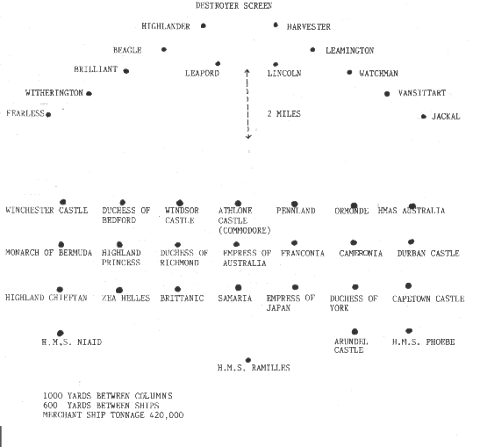Chapter 49: Beating a chained foe to death
Although the British force attached to convoy HX7 on paper was formidable, it would soon turn out that their mission to protect a convoy of slow moving merchant ships made the proud royal navy ships into sitting ducks. Scouting had quickly turned into suicide missions as the visibility was awful and the British, unlike the Germans did not have reliable radar (cf. chapter 37). Had these tactical disadvantages been fully clear to Admiral Edward Syfret, overall commander aboard the Nelson, what came next would have been seen as inevitable. After establishing the approximate position of the British battleships and carriers at the end of the convoy by a trailing type XVII submarine (cf. chapter 39), the submarine initiated the battle with the pre-established signal. A trail of torpedoes fired into a large British warship, in this case the Rodney. As the torpedoes were fired at a relatively safe distance, only two torpedoes hit the HMS Rodney, and while the amidships strike hit straight at the torpedo defense system, this had not been designed for the 9 m long 60 cm torpedoes used by the German submarine (cf. chapter 28). It burst and released flames, fumes, water and fire into the belly of the ship. The aft hit destroyed the port turbines, again causing extensive flooding and a major list o port, initially threatening to capsize before counter flooding stabilized Rodney somewhat. The burning Rodney formed a nice illuminative background for what came next: 11 of the trailing German destroyers came out into a torpedo assault firing at the rear of the enormous convoy. Aiming was intended towards the Nelson and the two carriers although at a range of 7-8 miles, a lot of movement by the target was possible. However, when your are zig-zagging at 15 knots, 50 knots of torpedo speed will close the gap rather fast and there is not that much you can do to avoid being struck with close to 90 torpedoes in the water.
At his occasion, despite being pre-occupied by chasing the German submarine which crippled Rodney, the British did manage to bring their guns to bear on the Germans and firing from the Nelson, 5 cruisers (2 were in the front to protect against this kind of event) 8 destroyers did manage to lay 15 cm hits on 7 of the destroyers, sinking two and seriously crippling 2 more, but the worst was clearly to come. The German torpedoes made their mark on 1 destroyer, 1 of the cruisers, which both sank and Nelson was hit by a torpedo in the stern bringing her port machinery to a halt and Resolution took a hit amidships which brushed aside all defense systems leaving her to capsize. A further hit was struck on Ark Royals sister ship Warrior setting off fires in stored aviation fuels and 5 merchant ships were struck and sunk by misfired torpedoes. A major night-time melee now followed as 17 German submarines penetrated the front of the convoy and the trailing British destroyers went in pursuit of the retreating German destroyer force. This led to the sinking of the two crippled German destroyers, but also to the encounter between the British destroyers and the German cruisers and battleships. In this melee,a German light cruiser was struck by a British torpedo and sunk, but the British destroyers were almost annihilated, and events unfolded from here. The German XVII submarine had dived deep following the torpedoing of the Rodney, but knowing the tactical plan, he had now deduced that he was no longer being chased and he returned to periscope depth with reloaded torpedoes. In an unrivalled display of opportunism he approached the damaged and slow moving HMS Nelson before sending a spread of a further 4 torpedoes into her*. The torpedo hits set off secondary explosion at the 6 inch caliber magazines and she sank rapidly in an explosive fireworks display. When the captain, a soon to be infamous Günther Prien, radioed in that both the Nelrods were incapacitated, an knowing that the aftermost destroyers were sunk and those in the front engaed in ASW, the German admiral Lütjens decided that conditions were now favorable and moved in for the kill.
With the sun about to emerge behind the clouds, he encountered Ramillies in fighting spirit, but soon showered her in 16.5 inch shells from the three German battleships. Ramillies did land hits in return, but it was not the gunfight which proved the most costly to the Germans. A type T submarine had also been trailing the British convoy and it did land two torpedoes into the side of the Moltke. Moltke withdrew to lick her wounds as the Germans pursued to claim the Ramillies, the Rodney and Ark Royals sister ship Warrior losing another heavy cruiser in the foray.
Previously, the captain on the Ark Royal had been quick to react and in the face of the initial German torpedo spread he moved ahead into the convoy. Realizing he was now in command, he ordered the dispersal of the convoy and set his own escape route at 30 knots heading North-East with 3 cruisers ordered to his side. As daylight approached, the slaughter commenced in earnest, while the Royal Navy was making its escape.
*I would think that with 1939 ASW, tying a battleship to a 9 knot convoy would be suicide with 14 knot submerged submarines around. Obviously, the tactics of this convoy would not be repeated, but lessons can be expensive.
